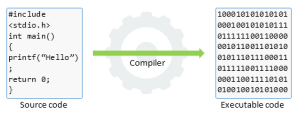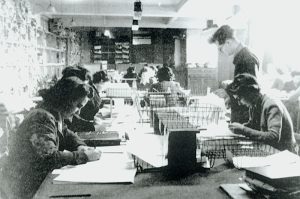Digital Information Environment
57 The Women Who Shape Code
Ethan Coffey
Introduction
Human life has advanced in a significant way over the course of its existence, with innovations going from first learning to use fire, to now creating an AI Model that can interact and provide information in a conversational way (Roose). In the last 200 years, we have seen advancements increase at a pace so rapid that it’s impossible for everyone to keep up with the full extent of new breakthroughs.
A monumental development from this time period is what is now known as “coding”, which is what helped create things like software (apps), hardware (the device used to view/print this document), and much more. When we think of coding today, we often think of names like Steve Jobs due to Apple, or Bill Gates due to his involvement with Microsoft. What many people don’t realize, however, is how many individuals were influential in developing code far before that, while not receiving nearly enough credit. The most famous and most recognizable faces within the tech world have largely been white males, but behind the scenes, there have been countless women who have been just as important, if not more so than many of the names we know today.
Coding and it Creations
Technology is something that has been around humans for centuries, helping to advance the current society into something more effective than it was before. The technology of the past (like the wheel) has almost always found its way to evolve and have continued relevance in the future. Coding is something that has appeared rather recently, less than 100 years ago, but has already brought enormous changes to society.
The first type of code that was created was in 1949, and was called Short Code. Short code “required the programmer to change statements into 0’s and 1’s” (Ferguson, 2000). While this was a painstakingly difficult task, the creation of the first programming language help led to other prominent languages like JAVA, HTML and PYTHON. When it comes to programming now, there is no longer a need for the programmer to manually change to code into 0’s and 1’s due to the creation of the compiler. The compiler is a “program that turns the language’s statements into 0’s and 1’s for the computer to understand” (Ferguson).

This monumental achievement was created by Grace Hopper, who is considered to be “one of the first three “modern” programmers” (YaleNews,2021). Hopper was quite brilliant, having been taught in private schools since she was young. She graduated from Vassar College, and received a PHD in mathematics from the well-renowned Yale University (YaleNews). During her studies, Hopper was lucky enough to have the opportunity to work with a computer known as the “Mark I, one of the earliest electro mechanical computers” (YaleNews). This early exposure to such advanced technology at the time gave Hopper an advantage, and she made the most of it. Not coincidentally, she was instrumental in designing even more models of computers, such as the Mark II and Mark III (YaleNews). Grace Hopper and her contributions to the coding world cannot be understated, and we can still see her impact to this day.
Other application of Coding
While coding is often thought of as just being used to design websites or create applications, it is actually vital to just about every area of society, and has been for longer than one would think. Dating all the way back to World War II, there is evidence of militaries being heavily reliant on coding, and behind the scenes work of coders played a major role in the outcome of the war.
During World War II, the Germans were using technology known as Enigma machines, which were machines that “encrypted their messages”( Brereton, 30), which made their transmissions incredibly difficult to decode. With Allied Forces being able to consistently intercept but not decode German transmissions, teams were put together of people solely tasked with breaking the code. Fittingly, these people were simply termed “codebreakers”. A popular location for code breaking was “Bletchley Park, in the English countryside” (Brereton, 30). Oddly enough, most of the codebreakers did not know exactly what they were attempting to do, as they were only given bits and pieces to decode and never the full transmission. This was largely due to the sheer volume of information to be decoded, which meant progress was slow to say the least. Bletchley Park was quite the big operation, with at least 10,000 people work on this operation site.

While Bletchley Park is relatively well known at this point after hitting mainstream media in The Imitation Game, one lesser known fact is the impact that women had on the operation. Of the 10,000 people on site, “roughly 75 percent were women”( Brereton, 31). Of these women, Mavis Leaver and Margret Rock are two individuals credited with helping decode plans for World War II’s infamous battle, known as D-Day(Brereton, 32). Alan Turing is often given most of the credit for this breakthrough, and while he is a tremendous hero, Leaver and Rock have been left out of the story far too often.
Codebreaking is just one example of how coding can be used in various ways outside of its typical definition, but its importance is still not fully appreciated. Codebreakers were highly influential in turning the tide of the War, and many of them have never received any credit for the work that they did.
Rallying Women into Coding
For years the tech industry has been dominated by primarily white males, so getting more women into coding has been a focus in recent years. A great way that women can get into the world of coding is by attending what are known as coding boot camps. These boot camps “teach programming skills through intensive multi-week courses” (Lyon & Green, 2021), helping attendees catch up on how/why they should pursue coding.

While these boot camps are primarily informational, it has been seen that they often do influence women into pursuing jobs in the tech industry. According to studies taken regarding these boot camps, these boot camps “can be the catalyst for college educated women to attain computing jobs and career” (Lyon, & Green). Although a boot camp is a great start to get into coding, a lot more work would need to be done to achieve an even greater job.
Conclusion
When it comes down to it, coding has proved very important in our modern society, and its influence runs much deeper than one would typically imagine. Many of those who shaped code have their names known around the world, but there have been countless others whose impacts are still under-recognized. Women such as Grace Hopper, Mavis Leaver, and Margret Rock have been among the women who have helped make coding more reliable, dedicating their lives to understanding coding, and encouraging more women to join them in their endeavors. In the end, coding is going to be a powerful influence for years to come, and some brilliant women will likely be at the forefront.
References
Brereton. (2017). Women Scientists in Math and Coding. Gareth Stevens Publishing LLLP.
Ferguson, A. (2000). A History of Computer Programming Languages. A History of Computer Programming Languages. Retrieved December 2nd, 2021 https://cs.brown.edu/~adf/programming_languages.html
Grace Murray Hopper (1906–1992): A legacy of innovation and Service. YaleNews. (2021, November 18) Retrieved December 2nd, 2021
https://news.yale.edu/2017/02/10/grace-murray-hopper-1906-1992-legacy-innovation-and-service
Lyon, & Green, E. (2021). Coding Boot Camps: Enabling Women to Enter Computing Professions. ACM Transactions on Computing Education, 21(2), 1–30. https://doi.org/10.1145/3440891
Malloryk. (2020, February 28). Code girls: The untold story of the american women code breakers of World War II: The National WWII Museum: New Orleans. The National WWII Museum | New Orleans. Retrieved December 6, 2022, from https://www.nationalww2museum.org/war/articles/code-girls-untold-story-american-women-code-breakers-world-war-ii
Roose, K. (2022, December 5). The brilliance and weirdness of chatgpt. The New York Times. Retrieved December 6, 2022, from https://www.nytimes.com/2022/12/05/technology/chatgpt-ai-twitter.html

